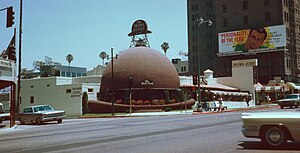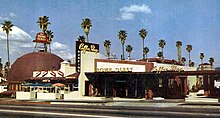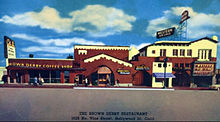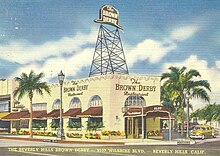Brown Derby
| Brown Derby | |
|---|---|
 The original Brown Derby on Wilshire Boulevard in Los Angeles, California, c. 1968 | |
 | |
| Restaurant information | |
| Established | 1926 |
| Previous owner(s) | Wilson Mizner |
| Food type | American |
| Dress code | Formal |
| Country | United States |
Brown Derby was a chain of restaurants in Los Angeles, California. The first and best known was shaped like a derby hat, an iconic image that became synonymous with the Golden Age of Hollywood. It was opened by Wilson Mizner in 1926.[1] The chain was started by Robert H. Cobb and Herbert K. Somborn (a former husband of film star Gloria Swanson) in the 1920s. The original Brown Derby restaurants had closed or had been converted to other uses by the 1980s, though a Disney-backed Brown Derby national franchising program revived the brand in the 21st century. It is often incorrectly thought that the Brown Derby was a single restaurant, and the Wilshire Boulevard and Hollywood branches are frequently confused.
There is a non-related chain of steakhouse restaurants founded in 1941 in Akron, Ohio, and franchised in 1962.[2] This chain was founded by Ted and Gus Girves, and the full name of these restaurants is "Girves Brown Derby". As of 2019[update], five of the Girves chain are still in business.
Wilshire Boulevard Brown Derby
First Wilshire Derby (at 3427)


The first restaurant was opened in February 1926 at 3427 Wilshire Boulevard in a building built in the distinctive shape of a derby hat.[3] Whimsical architecture was in vogue at the time, and the restaurant was designed to catch the eye of passing motorists. The Brown Derby name originated from a Malverne, New York-based restaurant of the same name that had been a hang-out for vaudevillians in the 1920s.[4] It was founded by Wilson Mizner as a small cafe, across the street from the Hollywood hot spot the Cocoanut Grove at the Ambassador Hotel. Wilson was the front man; Herbert K. Somborn owned the property and Jack L. Warner put up the money. Wilson Mizner sat in booth 50 almost every day.[5][1] Unfortunately the original restaurant was small and suffered from acoustic problems in which sound from one end of the building bounced off the semicircular ceiling and traveled to the other side of the room.[3]
Subsequent uses
Most of the rest of the block bounded by Wilshire Boulevard, Sixth Street, Mariposa Avenue and Alexandria Avenue was occupied by the Chapman Park Hotel and Bungalows which wanted to acquire the rest of the block that it did not own, including the lot that the original Derby had occupied.[6] After the restaurant moved out in May 1936, the building was demolished and the hotel was expanded and occupied by October of the same year.[7] The hotel itself was replaced in 1967 by the Equitable Life Building.[8][9][10]
Replacement Wilshire building (at 3377)
In 1936, a larger building, also in the shape of a hat, was constructed at 3377 Wilshire Boulevard at the northeast corner of Wilshire Boulevard and Alexandria Avenue, about a block from its previous location (and directly across the street from the Ambassador Hotel).[11] The restaurant was able to move into its new home in May of that year.[3]
In 1947's Fun and Fancy Free "Mickey and the Beanstalk", the cartoon ends with Willie the Giant's stomping through Hollywood looking for Mickey Mouse. Before the scene closes, Willie notices The Brown Derby restaurant and picks up the restaurant looking for Mickey. Willie notices the restaurant looks like a hat, places it on his head, and stomps off with the HOLLYWOOD lights blinking in the background.
In September 1980, the restaurant closed without warning.[12] Local preservationists worked to stop the building from being bulldozed,[13][14] and convinced developers to remove and restore the derby hat portion of the building. The rest of the restaurant building was demolished and replaced with a shopping center. The derby-shaped structure was placed on the roof of the new building.[15][16]
Subsequent uses
The parking lot was replaced in late 1985 by a shopping center known as the Brown Derby Plaza.[17] The domed structure was incorporated into the third floor of the building, and is currently vacant; it formerly accommodated a Korean bar (see photo at right with the brown dome in the recessed corner).[18][19]
Hollywood Brown Derby
This section needs additional citations for verification. (February 2018) |

Despite its less distinctive Spanish Mission style facade, the second Brown Derby, which opened on Valentine's Day 1929 at 1628 North Vine Street in Hollywood, was the branch that played the greater part in Hollywood history. Due to its proximity to movie studios, it became the place to do deals and be seen.
Clark Gable is said to have proposed to Carole Lombard there. Rival gossip columnists Louella Parsons and Hedda Hopper are recorded as regular patrons.
In the first of the Hollywood episodes of I Love Lucy ("L.A. at Last"), Lucy (Lucille Ball), Ethel (Vivian Vance), and Fred (William Frawley) have lunch at the Brown Derby. During the misadventure, the trio dines in a booth with Eve Arden on one side and William Holden (who orders a Cobb salad) on the other. This leads to the disaster scene in which Lucy inadvertently causes a waiter to hit Holden in the face with a pie.
Like its Wilshire Boulevard counterpart, it had a celebrity wall with hundreds of celebrity drawings, paintings and caricatures. Jack Lane drew many of these caricatures between 1947 and 1985.[20] Another artist whose work was displayed was Nicholas Volpe. He was commissioned by the Brown Derby to paint portraits of up to 200 top recording artists to be displayed in the restaurant's Hall of Fame Record Room.[21][22] In addition, his Oscar-winning star portraits were displayed in the restaurant's "Academy Room," created for showing Volpe's art.[23]
The Hollywood Brown Derby is the purported birthplace of the Cobb salad, which was said to have been hastily arranged from leftovers by owner Bob Cobb for showman and theater owner Sid Grauman. It was chopped fine, because Grauman had just had dental work done, and couldn't chew well.
According to Shirley Temple, the non-alcoholic drink bearing her name was invented at the Brown Derby in the mid-1930s. Temple herself never liked the drink and noted her personality rights had been used without permission.[24]
The Hollywood Brown Derby closed for the last time at its original site on April 3, 1985, as a result of a lease dispute.[25][26][27] The building was later occupied by a restaurant called Arbat Continental Restaurant when the building was hit by an early morning fire that destroyed the kitchen.[28][27] After the fire in 1987, the building remained unoccupied and deteriorated further while suffering frequent break-ins from homeless squatters and teenage gang members.[29] As a result of damage caused by the 1994 Northridge earthquake, the building at 1628 North Vine Street was declared unsafe by the City of Los Angeles and was the first building in Hollywood ordered to be demolished.[30] It was razed the following month.[27]
Subsequent uses
The building then was home to a restaurant and bar called Premieres of Hollywood, which catered to the revitalization of Hollywood Boulevard and the style of "Old Hollywood"; it offered an eclectic mix of American cuisine along with the original Cobb Salad (the recipe for which was found in the kitchen during the renovation).[citation needed] Premieres of Hollywood was destroyed during the L.A. riots in 1992. A few hand-painted wall tiles from the original Hollywood Brown Derby are held by the Jurus family, who started Premieres of Hollywood.
The land is now occupied by an apartment complex.
Later Brown Derby restaurants
After the original Hollywood Brown Derby at 1628 North Vine Street closed in April 1985 a spokesman for Walter P. Scharfe, who had purchased the chain a decade earlier, told the Los Angeles Times that the restaurant owner was “99% committed” to reopening the business at a new location.[26] Late in 1986 Scharfe opened a new Brown Derby in the Lieberg Building[31] at 911 E. Colorado Boulevard in Pasadena, California. The new restaurant would utilize the dark booths, crystal chandeliers, and 1500 caricatures [31] removed from the original location.[32] Scharfe opened another Brown Derby at 1707 N. Vine Street in Hollywood in October 1987.[33] The location had most recently been a Howard Johnson's coffee shop and reopened as a more casual version of the famous eatery with a large painted derby hat gracing the exterior walls.[34] In 1987 Scharfe told the Los Angeles Times that he had plans to open additional Brown Derby restaurants in Palm Springs, Honolulu, and Vancouver.[33] Both restaurants closed after a short time. In 1994 Scharfe opened another Brown Derby at the Beverly Center shopping mall. The small location featured miniature replicas of the famous caricatures and closed in less than one year.[35]
Beverly Hills Brown Derby

Bob Cobb opened the third Brown Derby in 1931 at 9537 Wilshire Boulevard in Beverly Hills,[36] across from the Beverly Wilshire Hotel. The building had previously housed a women's clothing store called "The Petite Shop.[37]" One of the dining areas was called The American Room and featured charcoal portraits of Academy Award-winning actors by artist Nicholas Volpe on the walls.[38] The Beverly Hills Brown Derby featured a revolving door (the first in Beverly Hills)[39] and a uniformed doorman.[40] A 1938 expansion with a bar[41] and private dining room[41] was called "The Derby House" and was decorated in Old English style.[41] It was closed in 1982 and demolished shortly afterwards.[42] Developer Douglas Stitzel purchased the vacant property in 1986 to build the One Rodeo shopping development.[42]
Los Feliz Brown Derby
The building that formerly housed the Los Feliz Brown Derby at 4500 Los Feliz Boulevard has been in use as a restaurant since the 1920s. Film mogul Cecil B. DeMille, a part owner of the Wilshire Blvd. restaurant, bought the building, a former chicken restaurant named Willard's, and converted it into a Brown Derby in 1940. It uniquely combined a formal restaurant with a dramatic domed ceiling with a more casual drive-in cafe outside. The building currently houses a restaurant called Mess Hall and a Chase bank.[43][44]
Subsequent uses
In 1960, it was purchased by actor Michael St. Angel (aka Steve Flagg) and became Michaels of Los Feliz,[45] and in 1992 it was transformed by new owners Tony and Tammi Gower [46] into a nightclub known as The Derby. In the late 1990s, it became one of the centers of the resurgence of swing dancing, which launched the careers of modern swing bands such as Big Bad Voodoo Daddy and Johnny Crawford. Oregon rock/swing/ska band the Cherry Poppin' Daddies recorded a song that cites the venue, titled "Brown Derby Jump", on their album Zoot Suit Riot.
The Derby was prominently featured in the 1996 film Swingers, in the scene where Jon Favreau and Vince Vaughn's characters bypass the line at the front door, enter through the service entrance, walk through the kitchen, and into the club where Big Bad Voodoo Daddy are playing on the stage, in an ode to the classic restaurant scene with Ray Liotta in Scorsese's Goodfellas.[47]

In June 2004, when Hillhurst/Los Feliz LLC purchased The Derby and adjacent lots with a view to demolition and replacement by a condominium complex, the planned redevelopment became a cause célèbre for historic preservation activists. An independent coalition called "Save The Derby" fought to prevent the demolition, and, on May 19, 2006, the Los Angeles City Council voted unanimously to designate the entire structure an official Historic Cultural Monument of the City of Los Angeles.[48]
In January 2009, the nightclub closed its doors.[49] The current landlord chose not to renew the lease, not long after a shooting inside the club. In 2012, the Los Feliz Brown Derby space is occupied by the gastropub Mess Hall Kitchen[50][51] and a Chase bank, dividing the dome in half between the businesses. The interior framing details of the dome construction have been exposed and are now visible from inside the restaurant.
Brown Derby Crenshaw Center
A fifth Brown Derby opened in 1955[52] at the Broadway Crenshaw Shopping Center, now known as the Baldwin Hills Crenshaw Plaza, in the Baldwin Hills neighborhood of Los Angeles. It was a 24-hour[52] coffee shop designed by architect Rowland Crawford and located near the center's Desmond's men's store[53][failed verification] The address was 3625 Stocker Avenue, Los Angeles, California.[54][failed verification] The location later became an early location of The International House of Pancakes[55][failed verification]
Licensing program
The Brown Derby began a licensing program[56] in 1987, with an agreement with The Walt Disney Company for a replica of the original Hollywood Brown Derby restaurant at the new Disney-MGM Studios in Lake Buena Vista, Florida. In 1990, the Walt Disney Company entered into three additional agreements for the Walt Disney Movie Studios at Disneyland Resort Paris, Tokyo Disney Sea at Tokyo Disney Resort and Disney California Adventure Park at Disneyland Resort in Anaheim, California. In 1996, a ten-year agreement was entered into with MGM Grand Las Vegas Las Vegas, Nevada; in 1998, the MGM Grand Detroit, Michigan temporary facility was added.
See also
Bibliography
- Alleman, Richard (1985). The Movie Lover's Guide to Hollywood. HarperCollins. ISBN 0-06-091262-6.
- Geary, George (2016). L.A.'s Legendary Restaurants. Santa Monica Press. ISBN 9781595800893.
- Willems, Mark (1996). The Brown Derby Restaurant: A Hollywood Legend. Rizzoli. ISBN 0847819256 – via Google Books.
References
- ^ a b Rubay, Donnell. "The Rogue and the Little Lady: The romance of Wilson Mizner and Anita Loos". The Bernica Herald. Archived from the original on January 5, 2014. Retrieved January 1, 2014.
- ^ "Brown Derby Forms Franchising Firm". The Akron Beacon Journal. September 23, 1962. Retrieved August 26, 2018 – via Newspapers.com.
- ^ a b c Scheuer, Philip K. (May 10, 1936). "A Town Called Hollywood". Los Angeles Times. p. C1. ProQuest 164618483.
Well, they got the hat moved across the street, all right; and last fortnight it was opened for business, "The hat" (it really should be in quotes) is the original Brown Derby Restaurant on Wilshire Boulevard. A landmark since February, 1926. it has long attracted by reason of its resemblance to Al Smith's headpiece and also, I am sure the management would be pleased to have me add, its food. The new place, just opposite the old one, at Alexandria, is rather more elaborate, although the hat part is almost exactly the same. Only the phenomenon is gone... No matter where you sat, you heard voices; and the closer you were to the wall, the louder they seemed.
- ^ Paolini, Matthew (November 21, 2007). "Historical Restaurant Mirrors Change In Los Angeles' Food And Drink Scene". IKnowNow. Archived from the original on August 21, 2013.
- ^ Burke, John (1975). Rogue's Progress. G. P. Putnam's Sons.
- ^ Read, Kendall (May 1, 1936). "Around and About in Hollywood". Los Angeles Times. p. 10. ProQuest 164626961.
- ^ "Plans Made for Pueblo: Wilshire Boulevard Block Will Be Occupied by Extensive Project". Los Angeles Times. May 17, 1936. p. E1. ProQuest 164623116.
Ten Spanish pueblo-type bungalows with apartments, facing a landscaped center and occupying an entire Wilshire Boulevard block... This project, constituting a distinctive little community of itself, will occupy the block fronting the Boulevard, Alexandria and Mariposa streets and will form an addition to the accommodations of the Chapman Park Hotel... The Brown Derby Cafe recently was moved to the northeast corner of the boulevard and Alexandria street to make way for the new pueblo project which is scheduled to be completed about October of this year.
- ^ Cameron, Tom (April 21, 1966). "Way Cleared for Construction of Wilshire Blvd. Skyscraper". Los Angeles Times. p. 3. ProQuest 155398230.
- ^ "Chapman Park Hotel to Be Modernized". Los Angeles Times. January 15, 1967. p. i7. ProQuest 155633153.
- ^ Sutherland, Henry (July 9, 1967). "Action Begins on 34-Story Equitable Tower: 34-STORY TOWER". Los Angeles Times. p. n1. ProQuest 155746125.
- ^ "Spanish-Type Home Newly Constructed". Los Angeles Times. March 15, 1936. p. E2. ProQuest 164574974.
- ^ Perlman, Jeffrey & Fannuchi, Kenneth (September 21, 1980). "L.A. Landmark: Brown Derby Closes Doors Amid Confusion". Los Angeles Times. p. A1. ProQuest 162920250.
The original, world famous Brown Derby restaurant has closed its doors abruptly, prompting questions from city officials and fears from citizens' groups that think the landmark may be replaced by a high-rise building.
- ^ Mehren, Elizabeth (September 29, 1980). "Another Version of Demolition Derby". Los Angeles Times. p. F1. ProQuest 162932031.
- ^ Mehren, Elizabeth (October 6, 1980). "Preservationists At Work: Conservancy's Edifice Complex Preservationists Work in L.A.". Los Angeles Times. p. F1. ProQuest 162984952.
- ^ Geary 2016, p. 261.
- ^ "Restaurant Demolished". Los Angeles Times. November 23, 1980. p. I21. ProQuest 162982973.
- ^ Ryon, Ruth (May 19, 1985). "Brown Derby to Crown New Shopping Plaza". Los Angeles Times.
- ^ "Zagat Buzz Blog: Then and Now: 11 Wretched Restaurant Reinventions". Zagat. June 23, 2010. Archived from the original on July 7, 2010.
- ^ "The Modernist's Guide to Iconic Wilshire Boulevard" (PDF). CicLAvia. February 3, 2015. Archived from the original (PDF) on November 1, 2014.
- ^ Lane, Jack. A Gallery of Stars: The Story of the Hollywood Brown Derby Wall of Fame, Luminary Press (2005)
- ^ "Storied Hollywood Brown Derby Art Collection Goes on Sale at San Francisco Art Exchange", Globe Newswire, October 27, 2014
- ^ Wanamaker, Marc. Beverly Hills: 1930-2005, Arcadia Publishing (2006) e-book
- ^ "Volpe: Portrait of an Artist", Beatlesportraits.com
- ^ Black, Shirley Temple (February 11, 2014). "nprchives" (Interview). Interviewed by Simon, Scott. tumblr.com. Retrieved January 30, 2017.
- ^ Scott, Vernon (April 3, 1985). "The famed Brown Derby restaurant on Vine Street closed..." United Press International.
- ^ a b Baker, Bob (April 4, 1985). "Last of the Brown Derbys Sadly Tips a Final Farewell". Los Angeles Times.
- ^ a b c Maher, Adrian (February 15, 1994). "Broken Hearts as Brown Derby Is Demolished". Los Angeles Times.
- ^ "Fire Hits Former Brown Derby". Los Angeles Times. September 8, 1987.
- ^ Pool, Bob (July 11, 1992). "Landmark Is Abandoned--Yet Again : Young Squatters Say Brown Derby Isn't a Safe Place to Live Anymore". Los Angeles Times.
- ^ Gordon, Larry (January 25, 1994). "Earthquake: The Long Road Back : Derby Demolition Begins Amid Protests". Los Angeles Times.
- ^ a b Dosti, Rose (December 26, 1986). "Pasadenans Warm to the Embrace of an Old Hollywood Favorite". Los Angeles Times.
- ^ Baker, Bob (October 11, 1986). "Brown Derbies Ready to Duel at the Drop of a Hat: DERBIES: Restaurants Ready to Duel at the Drop of a Hat". Los Angeles Times.
- ^ a b Harvey, Steve (October 23, 1987). "A New Brown Derby Tips Its Hat to Past". Los Angeles Times.
- ^ Ferrell, David (May 29, 1987). "Hollywood to Wear a New Brown Derby". Los Angeles Times.
- ^ Nichols, Chris (September 30, 2013). "Ask Chris: The Brown Derby's Mall Moment". Los Angeles magazine.
- ^ "'Get License,' Brokers Told". Los Angeles Times. November 1, 1931. p. D3. ProQuest 162506823.
The Wilshire Boulevard Association of Beverly Hills... reports that eighteen new places of business have opened on that thoroughfare in Beverly Hills since July 1, including Brown Derby Cafe...
{{cite news}}: CS1 maint: url-status (link) - ^ "Beverly Hills Then & Now" (PDF). Beverly Hills Weekly. April 24, 2014.
{{cite news}}: CS1 maint: url-status (link) - ^ Willems 1996, p. 85.
- ^ Willems 1996, p. 92.
- ^ Willems 1996, p. 93.
- ^ a b c Willems 1996, p. 96.
- ^ a b Ryon, Ruth (February 9, 1986). "Brown Derby Site in Beverly Hills Sold". Los Angeles Times.
- ^ Los Angeles magazine (November 26, 2012). "Mess Hall". Los Angeles magazine.
- ^ "No Martinis But Maybe Toasters: Los Feliz Derby to Become Bank". Curbed LA. Retrieved July 3, 2018.
- ^ "Estate Sells De Mille's Brown Derby". Los Angeles Times. March 16, 1960. p. B1. ProQuest 167685466.
- ^ Higgins, Bill (August 22, 1993). "A New Day for an Old Derby". Los Angeles Times.
- ^ Cowan, Jared (January 22, 2015). "Your Favorite Movies Were Filmed at These L.A. Restaurants and Bars". LA Weekly.
- ^ "Los Feliz Brown Derby Is Historic Monument". Los Angeles Times. May 20, 2006.
- ^ "The Derby in Los Feliz likely to close soon". Los Angeles Times. January 23, 2009.
- ^ Natividad, Amanda (September 14, 2012). "Mess Hall is open in Los Feliz". Los Angeles Times.
- ^ Gold, Jonathan (November 24, 2012). "Hello muddah, hello faddah ...: MessHall takes the flint spark of Scout trip memories and coaxes it into a themed restaurant with glassed-in fire pits, upscale but homey food and strictly counselor-cabin cocktails". Los Angeles Times.
- ^ a b Dudley, Fredda (May 1955). "Hollywood Holiday". Photoplay.[page needed]
- ^ "Coffee Shop Set For Brown Derby". Los Angeles Times. June 13, 1954.[page needed]
- ^ "Dining Out Directory". Los Angeles Times. December 23, 1956.[page needed]
- ^ "Display Ad". Los Angeles Times. December 15, 1977.[page needed]
- ^ Original Hollywood Brown Derby website
External links
- Website of The Original Hollywood Brown Derby – an affiliate of the original Hollywood location.
- Website outlining the history of the Los Feliz Brown Derby and the campaign to save it from demolition.
- A visual history of Yonge and Dundas
- Re Hollywood Brown Derby - the mission style "fragment that remains" is the facade of the Dinner Bell Cafe formerly at 1604-1/2 North Vine Street next to the Taft building - it is not a piece of Hollywood Brown Derby which was further down the street
- Movie clips showing interior and exterior of the original Wilshire Brown Derby, ca.1932
